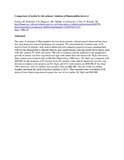| dc.description.abstract | The rates of isolation of Haemophilus ducreyi from patients with presumed chancroid has been low, and improved cultural techniques are required. We determined the isolation rates of H. ducreyi from 38 patients with clinical chancroid and compared gonococcal agar supplemented with bovine hemoglobin to Mueller-Hinton agar supplemented with chocolated horse blood, each with and without 5% fetal calf serum. The rate of isolation and the qualitative and quantitative growth of strains was best on gonococcal agar with added fetal calf serum (GC-HgS). However, three strains were isolated only on Mueller-Hinton base (MH-base). GC-HgS was compared with MH-HB for the isolation of H. ducreyi from 201 patients with clinical chancroid. Seventy-one percent of cultures were positive on GC-HgS, and 61% were positive on MH-HB (P less than .005); however, 10% of cultures were positive only on MH-HB. The use of the two media together increased the yield of positive cultures to 81%. Thus maximal rates of isolation of H. ducreyi from clinical specimens requires the use of two media, GC-HgS and MH-HB. | en |

